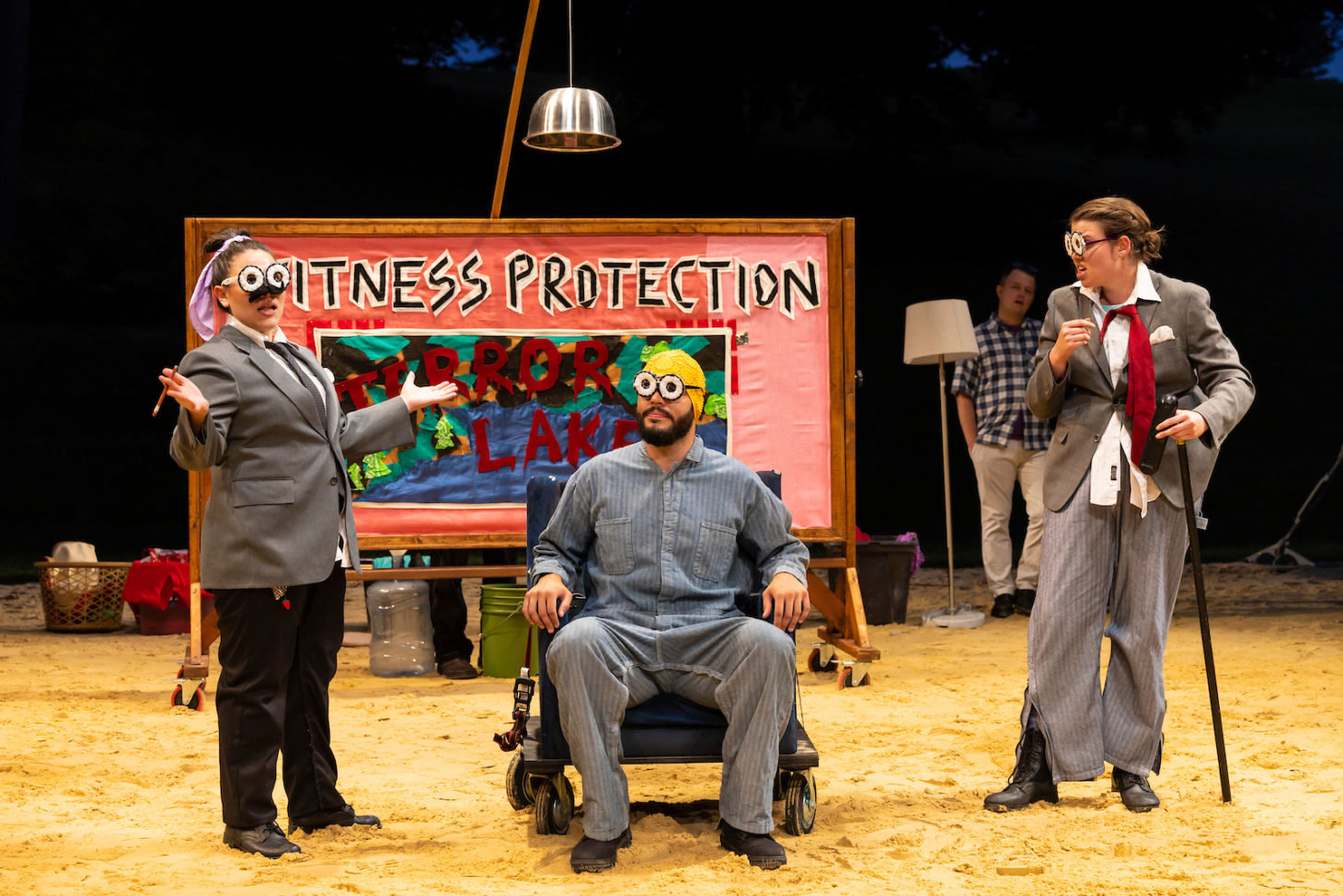‘Simpsons’-Inspired ‘Mr. Burns’ Takes the Stage in New York
Play looks at how people cope and connect in post-apocalyptic America

Saturnine nuclear energy titan Montgomery Burns may not get the majority of the plotlines in The Simpsons, but he’s the star of the show in a play being performed outside New York City. Mr. Burns, A Post-Electric Play is set after an apocalypse, and inspired by The Simpsons.
The first act sees a group around a campfire. A nuclear plant’s meltdown has brought on the apocalypse. Without electricity, as the title indicates, and television, the group recalls their favorite Simpsons episodes, including season five’s “Cape Feare.” That episode is a spoof of the two Cape Fear movies, from 1991 and 1962, with Sideshow Bob trying to kill Bart Simpson.
The second act is set seven years later, and a touring theater group performs Simpsons episodes, calling to mind, to a degree, HBO Max show Station Eleven, which features a touring theater group in a post-apocalyptic world, but no Simpsons. Act three is set 75 years into the future. It features a battle between good and evil, with Bart representing good, and Mr. Burns playing the part of evil. There may be a light sabre involved in their showdown.
The play is about how humans connect via stories and mythology, especially when no other diversions exist. Written by Anne Washburn and with a score by Michael Friedman, Mr. Burns is performed by the Hudson Valley Shakespeare Festival (HVSF) in Garrison, New York. It opened July 23 and closes September 17. Davis McCallum, HVSF artistic director, directs the play.
Roots in Sept. 11 and a Camping Trip
Mr. Burns was first performed in Washington, D.C., in 2012.
Washburn cited Sept. 11 as an influence for the project, as well as a camping trip she took as a fifth grader in California. As her classmates sat around a campfire, she and a colleague shared horror stories from a Hitchcock book they both had read. With no TV to watch, the children lapped it up.
“They were totally regaled by it,” she said. “We had suddenly enormous social currency. There was a very valuable commodity in those stories.”
Broadcasting & Cable Newsletter
The smarter way to stay on top of broadcasting and cable industry. Sign up below
Washburn described herself as a “casual” Simpsons watcher. She recalled getting home from a temp job not long after finishing college, and sitting with a takeout dinner, watching TV. “I was happy to get reruns of The Simpsons and Friends in the 7-8 p.m. hour,” she said.
Washburn considered Friends, Seinfeld and Cheers when setting up the structure of her play, then settled on Bart, Burns and the gang. The animated show was (and remains) popular, funny and “scandalous,” she said.

Matt Groening created The Simpsons. Season 34 starts on Fox September 25. Seasons 1-32 are on Disney Plus.
In terms of getting the OK from The Simpsons producers or Fox, Washburn said the Mr. Burns principals believed the play was covered under fair use. A Fox spokesperson said the network is aware of the play, but it is not authorized or sanctioned by Fox or the series.
After its premiere by Woolly Mammoth Theatre Company in Washington, Mr. Burns ventured to New York as part of Playwrights Horizons in 2013. It has also been performed in Chicago, Seattle, London, Sweden and countless other places, including high school productions.
Bringing ‘Burns’ to New York
Director McCallum and Washburn have been friends for years–”since I was a baby playwright and he was a baby director,” said Washburn–and he felt the time was right to perform it under the HVSF tent. “After 2 ½ years of the pandemic, and all the loss and the trauma, I thought, maybe this is a play that comes back to the top of the list,” he said. “It’s about human resilience. I thought it was a timely set of questions for this moment.”
Asked if Mr. Burns is a comedy or drama, McCallum said it is hard to categorize. “It’s certainly funny, but it has weighty and serious topics on its mind,” he said.
Besides Mr. Burns, HVSF offers Romeo & Juliet and Madeline Sayet’s Where We Belong this summer. After years at Boscobel House and Gardens, also in Garrison, HVSF now sits on a 98-acre former golf course in between Albany Post Road and the Hudson River, around 52 miles north of 42nd Street in Manhattan.
A Character Audiences Love to Hate
Bart represents good, Washburn said, because he’s relatively well equipped for the post-apocalyptic world. “He’s a pain in the ass, but he has many of the qualities that are really necessary if we go south,” she said, mentioning “stick-to-it-iveness” and stubbornness.
Mr. Burns represents evil. Zachary Fine plays Burns. He first saw the play in New York in 2013, and it never really left his mind. “The script was dizzying in its accumulation of ideas about how we make myths and stories, and how we survive as a species when things don’t go well,” he said.
Fine said Washburn has concocted a “great villain” in Burns, the man representing capitalism, consumerism and of course nuclear energy. “It’s fun to play a really smart, conniving, passionate villain who everybody loves to hate,” said Fine. “The audience is really ready to enjoy that.”
The New York Times reviewed the play last week. “Mr. Burns explores the ways that we use stories, even seemingly irrelevant stories, to make sense of our lives,” it said. “Mr. Burns is a play about where we find comfort and it is also, more chillingly, about the limits of that comfort, about how reality can intrude even before the credits roll.”
One doesn’t have to be a Simpsons die-hard to enjoy Mr. Burns. “If you’re a Simpsons fan, there’s a lot to love in this,” McCallum said. “But you don’t have to know anything about The Simpsons to appreciate the play.” ■
Michael Malone is content director at B+C and Multichannel News. He joined B+C in 2005 and has covered network programming, including entertainment, news and sports on broadcast, cable and streaming; and local broadcast television, including writing the "Local News Close-Up" market profiles. He also hosted the podcasts "Busted Pilot" and "Series Business." His journalism has also appeared in The New York Times, The L.A. Times, The Boston Globe and New York magazine.

